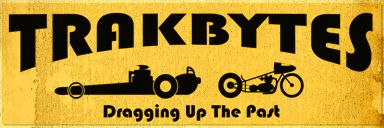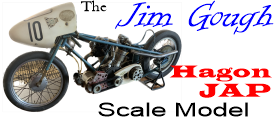
Whilst collecting photos for the Alf Hagon story in the 2024 series of Pioneer Stories on Eurodragster, fellow British Drag Racing Historian Jerry Cookson sent me some images of relevant material I might be able to use. Amongst them was a scan of a copy of Scale Models magazine from April 1970 that Jerry had picked up for £2 at a market stall in Bridport, during the town's Hat Festival. On the top right of the six pictures on the front cover is a photo of Alf Hagon's JAP which, despite appearances, is not quite what it seems. Another scan from inside the magazine revealed that this was a scratch-built model of the famous bike, created in 1968/69 by a Mr. J. W. W. Gough. My first thought as I looked at Jerry's scans was "how come I've only just found out about this?", my second was "what a remarkable piece of work". My third thought was naturally "where is it now?"
 |
 |
 |
I contacted Jerry, and also John Hunt who is the man responsible for recording and transcribing all the Pioneers Stories interviews. Neither of them had any more details to offer but John asked Martin Hagon if he knew anything of the model. Within a couple of days he had the phone number of its current custodian, which he passed on to me. A few days later I had arranged a visit to view the model as, by pure coincidence, I was going to be enjoying a weekend away with friends not that far away from its current home.
Colin Peters is the proud man who now owns this unique piece of memorabilia, and he's only the second owner since its creation. He lives in a bungalow on the Kent Coast which is a fascinating place for a person such as myself to visit. He, like Alf, had been a Grass track racer, retiring from riding in 1985, and his home is decorated with photos and memorabilia from his days in the saddle. His living room also contains a reinforced display cabinet which houses half a dozen pristine, and in some cases rare, JAP and Weslake engines. I can imagine the reaction from my extremely tolerant wife if I should suggest that full size engines would make excellent and attractive household ornaments...
The 22 inch long model itself has pride of place at the end of the room in a purpose built mirror-backed illuminated display case, mounted high on the wall above the television. Maybe it was my anticipation of the moment but as soon as you set eyes on it you can tell it is something special. Although it is fair to say that it is showing signs of its age it is still in excellent condition, and, having spent a lot of time admiring and photographing Alf's bike, I can tell you it is a remarkably detailed and faithful copy. We held our breath as Colin ascended a small set of steps, opened the cabinet, and gently lifted the bike out before placing it carefully on the kitchen counter.
 Colin's wife's uncle, Pat Sims (#32) alongside Alf Hagon (#156) at Knatts Valley Hill Climb in the 1950s |
"The story behind the quarter scale scratch-built model that I have today, started back in 2001. I always admired Alf's achievements on his V twin J.A.P. I always fancied owning one but the chances of ever achieving that were very slim, due to the fact only a very few were built in the 60s/70s and even fewer, if any, existed at this later time. If you were lucky enough to find one the cost would have been prohibitive in my case. I believe Martin had to go to Australia to purchase Alf's bike back in a sorry state, what year I can't recall. Then I saw an advert for the Classic Motor Cycle Show at Stafford showground dated 20th/21st October 2001. Bonhams Auction house (then Bonhams & Brooks) always have an auction on the Sunday of the show weekend. I knew Malcolm Barber the auctioneer and acquired a catalogue to find that LOT 335 was a scratch-built model of Alf's 200mph Sprinter built by a Mr Gough in 1967/68. That weekend I bought some tickets for the show and set off to have a look at LOT 335. It was amazing. Quite excited at the end of Saturday I set off to look for and book into my hotel. On arriving I saw at the reception desk a face I knew, Martin Hagon! I thought I know what he has come for! Fortunately, I don't think he knew of LOT 335 in the sale, He had a stand at the show promoting his shock absorber business. On Sunday morning, I was up, straight to the show, and into the auction room waiting for LOT335. I believe only one other person bid on the model and I don't believe it was Martin. Needless to say, I was successful. I am the proud owner of an Alf Hagon 200+ mph V Twin J.A.P. sprinter, albeit quarter size."
Colin collected the bike after the auction which had been transported there in a purpose-built case that "looked like it had been constructed out of cornflake packets". "I ended up paying more than I wanted to for it" he recalls, "But I guess I wanted it more than the other bloke". He knew very little of the history of the bike, and so he wrote to Bonhams & Brooks with a request for the vendor to contact him with a view to providing a bit more of the model's history. But, possibly due to client confidentiality, he never received a reply. The auction brochure stated that the vendor was the builder of the model. Quite why he had decided to sell it we can only speculate.
Here's what we have been able to find out about the history of the model and it's creator.
J. W. W. Gough was Jim Gough, who hailed from Colindale, or Hendon, depending on which publication you refer to. He was born in 1938. He was a family man and had an enthusiasm for scale engineering and motorcycles. Finding any further information on him has proved to be fruitless, so far.
 Alf and the bike in 1967 |
 Drag Racing & Hot Rod Magazine October 1967 |
In 1967 Alf Hagon was breaking new barriers with his mighty JAP V-Twin, becoming the first rider outside the USA to break through the ten second mark with a 9.93s run at Duxford in July. In August he improved upon this with two nine second runs at Santa Pod. The first was a 9.93. He then ran a 9.679 at 143.88mph. This time was the quickest on two wheels anywhere in the world. He went on to set the official standing-start quarter mile record at Elvington in October with an average of 9.9545s. Jim, being a model engineer and keen motorcyclist himself, contacted Alf and asked if he could come and take measurements and photos of the bike with a view to constructing a precision engineered quarter scale replica. Alf was more than accommodating of this request, perhaps recognising a similar talent for engineering as his own. He not only allowed Jim access to the bike but supplied him with various materials which were used for machining some of the model's parts. I asked Alf if he had any memories of Jim, and, although he remembers Jim coming to visit, he was unable to recall much about him. He did tell me that Jim brought the model to show him when it was completed and Alf still has some photos of it in his collection.
Jim set to work with just a 6-inch lathe, a small pillar drill and a selection of hand tools. Wherever possible he used correspondingly correct materials, some of which came from Alf's workshop. The engine isn't just an accurate replica on the outside, all the internals, pistons, crank and valve gear are faithfully and meticulously reproduced. The crankcase halves are machined from magnesium that came from an actual JAP crankcase that was used on the real bike. The French Blue paint on the frame is also authentic as that too came from Alf. The Shorrocks blower is also fully operational. The drive chain is entirely scratch built and, in a quest for complete authenticity, the primary chain was not fitted, as Alf's bike had no gearbox and to provide a neutral, which was required to move the machine around, the primary was only fitted prior to a run. The bowden cables for the clutch, throttle and brakes were self-made and the handlebar levers and twistgrip provide the necessary force to operate the fully functional clutch, injector and brake calipers. Jim's remarkable skill in machining meant that he was able to manufacture not only all the main parts of the bike but all the fasteners as well. He made all the screws, nuts, bolts and washers, the springs and even the tiny jubilee clips. How do you make your own scaled down tyres for a project such as this? You painstakingly carve them from solid pieces of rubber of course. Even the tread pattern on the front is period-correct and accurate. The images below show some comparison photos. The model is unchanged from the 1967 version whilst the real bike has been restored since being retrieved from Australia.
|
Top - Model, Bottom - Alf's Bike |
Top - Model, Bottom - Alf's Bike |
Top - Alf's Bike, Bottom - Model |
You are probably starting to get the idea. Jim scratch-built just about everything on the model, and everything is perfectly scaled down and functional. Even the welds of the manifolds are correctly executed. The only areas where there are differences are the various bearings, plain bronze was used instead of ball or roller races, and the engine does not contain a lubrication system. One other difference remains. Jim could not find a way to wire the BTH magnetos due to their miniscule size. For this reason the spark plug holes contain glow plugs, the only items on the model that were shop bought. Did I mention that the 19.6cc engine actually runs? Well, it did. Jim fired it up after it was built, but that is thought to be the only time it was run. Colin admits that he has never tried to run it himself due to the long period of time between its construction and his purchase.
Jim estimated that it took him 650 hours to build over a period of eighteen months. It was completed in November 1969, around the same time that Alf announced his retirement from racing, and the real bike was put up for sale. The completion date of the model fell just in time for a model show organised by the Society of Harrow and Wembley Model Engineers, held at the British Rail Midland Region Sports Pavilion in Harrow on November 29th. Jim told the reporter from the Harrow Observer that he had only just finished the model that morning and still had the transfers to apply. As well as the Hagon JAP Jim exhibited another model. This one was an equally impressive and accurate recreation of his own 1928 Model 80 Sunbeam racing motorcycle. I have only been able to find one picture of this model. The current location of this companion piece is unknown.
 Jim's model of his own 1928 Model 80 Sunbeam |
 The JAP from model Engineer Magazine |
The next outing for the two bikes was the Model Engineer Exhibition held at London's Seymour Hall, which ran for two weeks from December 31st 1969. Jim won silver medals for both models in the "Mechanically Propelled Road Vehicles" class, and photos appeared in "Model Engineer" and "Scale Models" magazines reviews of the event.
It is not known if either model was displayed after that. It seems likely that Jim would have done so, but records of any other appearances or awards have not been found.
 Alf signing Colin's photo of the model in 2006 |
These days we are used to seeing superbly detailed mass-produced models of our favourite race machinery, manufacured to exacting levels of detail with the aid of modern production techniques, computer-aided design, and even 3D printing. Almost anything can be produced in a miniature form, and the only limitations involved in owning a superbly detailed model of a favourite car or bike are down to how much you are willing to pay for such an item. But fifty years ago these methods were all but non-existent and those that had the skills, or were learning them, used them to produce their own versions. Thankfully there are still many enthusiasts who continue to engineer their own models, with excellent and impressive results, but I suspect there are fewer of them these days, and I wonder if such a pastime will continue to appeal to future generations. It would be a shame if these skills were lost, as a bespoke scratch-built and unique model is always more impressive than a mass-produced item.
One person who is keeping the spirit of those model engineers alive, and trying to encourage todays new generations, is Neil Baskerville, son of Ray, who was a contemporary of Alf's in the early days of British drag bike racing. Neil is building his own quarter scale model of Hagon's bike. He acquired a copy of the Scale Models magazine that featured Jim's bike after being told about it by a racer friend who saw the exhibit at the 1970 show. "I'm very keen to keep nostalgia alive and kicking" Neil told me, "and to recognise all the people who made the sport what it is. I'm not really a modeller, so mine will be a bit more basic, although I would like a working engine. I started it to try and get the kids interested in building and also Drag Racing... so far I've failed on both fronts, so it's a long-term project. I'm hoping to get the frame finished soon."
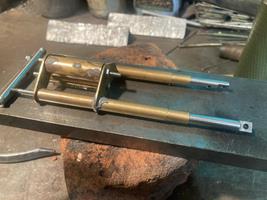 |
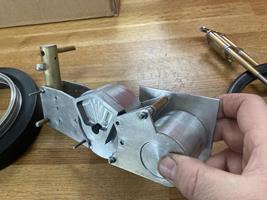 |
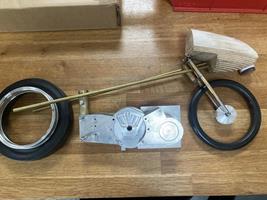 |
| Under construction. Neil Baskervilles model is still in it's early stages. | ||
The Jim Gough model is certainly impressive. In fact, in my opinion, it is more than a model. It is a fully-working motorcycle in miniature, and a work of art. It has survived for half a century and stands as a remarkable testament to the dedication, skill and patience of a very talented man.
My thanks to Colin Peters for allowing us to visit his home and view the model, to Alf Hagon and Neil Baskerville for their input, to Jerry Cookson and John Hunt for sowing the seeds of the idea for this article, and my buddy Glen Hehn who did the driving on the day, asked some questions I hadn't thought of, and took some of the photos I've used.
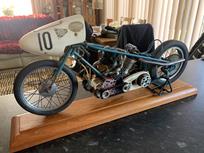 |
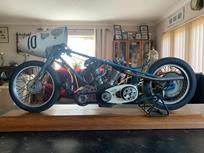 |
||
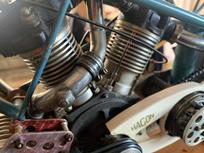 |
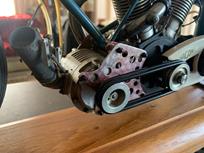 |
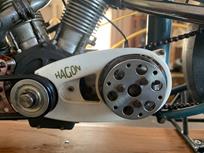 |
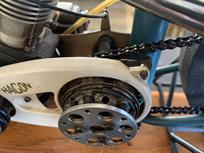 |
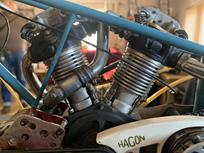 |
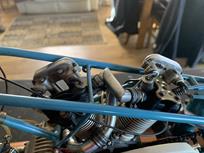 |
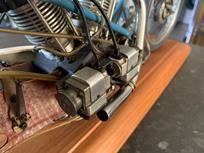 |
|
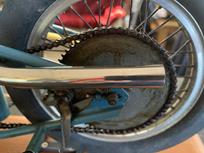 |
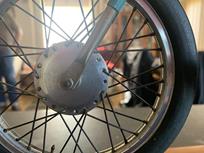 |
||
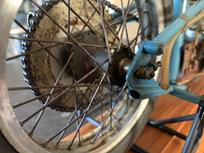 |
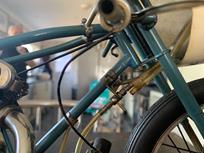 |
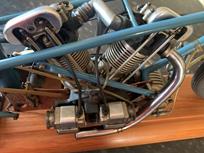 |
|
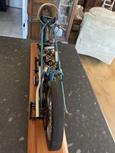 |
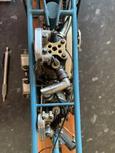 |
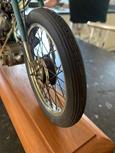 |

